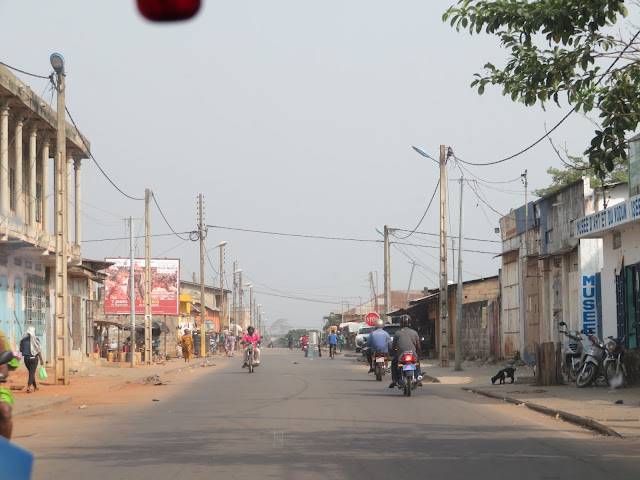driving around Porto-Novo
Last year, I explored Ouidah, a city in modern-day Benin. It was a significant location in the transatlantic slave trade when it was still known as Fortaleza de São João Batista de Ajudá. For my next visit to Benin, Val took me on a car tour of Benin's capital, Porto-Novo, another city whose name suggests a prominent Portuguese history. For me, it is fascinating to find a city with a Portuguese name in a country where people largely spoke French.
Upon crossing the bridge from Cotonou, the first thing I saw was a government building that's currently under construction. It sat right by the banks of an inlet of the Gulf of Guinea.
In downtown Porto-Novo, the pace was much slower than in Cotonou. There weren't many multi-story buildings where we drove past. There are fewer vehicles on the roads here... but it could also be because we drove in when people were currently at work. There were not as many tourists as in Cotonou too. What I noticed (again) was the presence of what looked like the West African dwarf goat, a very robust breed of goat.
 |
| Downtown Porto-Novo |
I was bugging Val to bring me to museums so I could learn more about the city's and the country's culture and history. However, many of the museums were closed because of a festival that was happening during that weekend. Hence, I had to content myself with just driving past one of the museums: Palais Royal-Honme-Afin-Oba. It's a royal palace before and has been turned into a museum. I'm sure that I'll get to see it someday.
 |
| King Toffa's Palace |
We also passed by a statue of a man who Val said was a comedian. Looking more closely at the title below the statue, it says that the place is the headquarters of the national people's theatre. This man, therefore, must have been a very famous comedian, to be honoured that way with a statue.
 |
| National People's Theatre |
Based on my first and second trips to Benin, I learn that his is a country where people of various religious belief systems live together in peace. Several places of worship are in close proximity with each other, for instance. For the first time, I've seen a Yoruba Abessan temple. It appears to be made of the same red soil found in the city. Apparently, it is a temple paying homage to a nine-headed deity.
 |
| Yoruba Abessan temple |
Not far from the temple are what appears to be two mosques. The yellow-and-grey mosque was easy to notice from the main road because of the architecture. But I mistook the red building as a Roman Catholic church because of the strong European elements... in fact, I was reminded of the Baroque churches in the Philippines. I would have wanted to see it up close but we still had people to visit; hence, we were just passing through this time.
 |
| Mosque |
The Catholic church is also nearby. It seems like the newest structure among the religious buildings we've passed on this short road trip around Porto-Novo. Actually, it reminded me of the San Isidro Labrador Church in Pasay City. We were able to drive to the side of the church but we were not able to go inside because it was closed.
 |
| Porto-Novo Cathedral |
After that brief tour around the downtown area of Porto-Novo, it was time to head to the residential area. I should be used to the view by now because I've seen it in India and in Benin during my previous travels... but I am always taken aback by how red the soil is. It's such a stark difference from what I normally see in Manila or in San Francisco, for example. Plus, there's a sprinkling of extremely tall trees in the hazy distance.

Porto-Novo is definitely a city I'll be visiting again. This trip was just a preview of a deeper dive into its culture and its history. It's most likely going to be fascinating because, like Manila, Porto-Novo has been under European rule for several centuries. Seeing how different cultures blend into how the city currently identifies itself is going to be interesting.


Comments
Post a Comment
Thank you for dropping by!
Before moving on, please share your thoughts or comments about the post. :)
Thanks again!